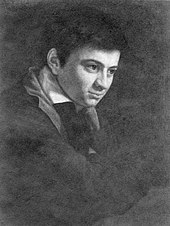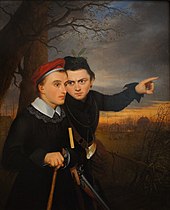Adolf Zimmermann

Adolf Gottlob Zimmermann (born September 1, 1799 in Lodenau - Neusorge , Oberlausitz; † July 17, 1859 in Breslau ) was a German painter and belonged to the Nazarene group of artists at the Düsseldorf School of Painting .
Live and act
The father Johann Gottlob Zimmermann was a manorial servant at Lodenau Castle to Count Adolf Friedrich Abraham von Gersdorf. For his loyal service he received a piece of land in Neusorge as well as some rights for a future livelihood as a reward. The count took over the sponsorship of the first-born son Adolf and provided financial support for his future education.
Adolf Zimmermann was a student at the Herrnhuter Pedagogy in Niesky , where his artistic talent was also encouraged. Afterwards he was supposed to learn a trade in Herrnhut . He evaded this determination, probably with the support of the manor, and went to the art academy in Dresden , which accepted him as a student. From 1818 to 1825 he studied painting with Ferdinand Hartmann and Johann Carl Rößler , who came from Görlitz . His fellow students included Wilhelm von Kügelgen , Karl Heinrich Koopmann and Carl Gottlieb Peschel .
After completing his studies, Zimmermann received a royal scholarship on the recommendation of the director of the academy, Count Heinrich Vitzthum von Eckstädt , to undertake an educational trip to Italy . In the fall of 1825 he set out for Rome with his friend Carl Peschel . The journey took them to Stuttgart , where they visited the sculptor Johann Heinrich Dannecker , via Munich , where they met Peter von Cornelius on the painters' scaffolding in the Glyptothek , on to Tyrol , Switzerland and across the Alps to Italy.
Zimmermann reached Rome on November 7, 1825. There he met artist colleagues such as Ludwig Richter , Friedrich Overbeck , Julius Schnorr von Carolsfeld , Bonaventura Genelli and moved in with the painter Adolf Lößner.
Zimmermann sketched landscapes and studied the great painters. A highlight of his stay was probably the excursion with Joseph von Führich , with whom he visited the antiquities and art treasures in Naples and on Capri . On this occasion he also got to know the painters Carl Blechen and August Kopisch .
In 1826 Zimmermann received royal support for his studies in Rome for two more years. The painter surprisingly used the scholarship granted for 1829 for his return trip to Germany.
The faithful, evangelical carpenter left Rome probably due to religious disputes, because he did not convert to the Catholic faith like many of his painter colleagues. It was of the opinion that only with a Catholic worldview one could create great things in biblical history painting. In a letter, he explained to his bride his intention to leave Italy, but with the fact that he could not do much with the support he had received and that additional funds had not been granted to him.
In April 1830 the painter set off for Germany with filled sketchbooks. He finally got back to Dresden via Pisa , Perugia , Florence , Fiesole , Venice , Graubünden , Schaffhausen , Freiburg im Breisgau , Frankfurt am Main and Cologne .
He took up residence in the Pirnaische Vorstadt on the Elbe and worked as a drawing teacher and portrait painter. The latter was not enough for Zimmermann, because he was strongly drawn to historical-biblical painting. He also complained about the order situation: “The number of artists increases to the same extent as the interest of the public decreases.” In 1834 he decided to leave Dresden.
With a letter of recommendation to the wealthy Westphalian nobility, Zimmermann settled in Münster and received several orders.
In autumn 1834 a Düsseldorf artist visited him. He raved about the academy there and advised him to present his Dresden work there. Following the advice, the painter was also able to sell one of his pictures. Then he met with Wilhelm von Schadow , the director of the art academy , and moved to Düsseldorf for the “divine art” in the winter of 1834/35.
The romantic Schadow wanted to move away from the artificial stylized painting style and back towards naturalness. The concept and its teaching talent helped the Düsseldorf School of Painting to achieve an excellent reputation and many successes at art exhibitions. Despite the large crowds, he accepted Zimmermann in the master class as a self-employed artist and initially promoted him.
A second time Zimmermann got into a religious war that broke out between the East German, predominantly Protestant artists appointed to the academy and the established, Catholic Rhinelanders. Schadow, who had converted to the Catholic faith in Rome, opposed the emerging Protestant artists. For the sensitive carpenter, for whom religion was a need, a hard time of suffering began.
Since the painter had earned well in recent years, he decided in 1837 to marry his long-time bride and bring her to Düsseldorf. Due to a lack of sales opportunities as a result of the political and theological disputes, the couple's financial situation has now deteriorated. The wife therefore decided in 1842 to return to her parents' house with the two boys in order to reduce the high household costs. The separation from his family with his daughter, who had now been born, his poor health since Rome and the ongoing religious disputes made the painter think about leaving Düsseldorf.
The art historian Karl Schnaase recommended Zimmermann to go to Breslau, since he thought the city ideal for a hardworking painter due to the lack of competition. Zimmermann then asked his former pastor in Rome, the Heidelberg professor of theology Richard Rothe , for advice. Rothe fondly remembered his loyal parishioner and wrote to his brother-in-law, the superintendent August Hahn in Breslau, with the request to take care of the painter.
Zimmermann moved to Breslau with his family in 1846. On the basis of a few recommendations, the artist soon received commissions, initially mainly portraits and a few biblical pictures. One of his clients was the Catholic prince-bishop Heinrich Förster . The art-savvy clergyman bought some pictures with biblical subjects from Zimmermann and commissioned the painter to copy some of his work.
At the beginning of the 1850s Zimmermann complained about constantly falling prices for his work. The nobility paid poorly due to poor harvests. For a small fee he often portrayed on their estates far from Breslau.
When Zimmermann's eyesight was declining around 1855 and he was also weakened by an illness similar to cholera , the painter received financial help from many professional colleagues, especially from his friend Hermann Plüddemann , who had moved to Dresden . High Tribunal Councilor Schnaase tried in vain to get him a teaching position and also asked for financial aid, but also unsuccessfully.
Zimmermann died in Breslau on July 17, 1859. "A [...] tired fighter for 'divine art', of which he has remained a pure disciple despite all hostility and disappointments."
family
Zimmermann often stayed in Niesky during his studies. During this time he painted some portraits of wealthy citizens. On one such occasion he met the daughters of the soap manufacturer Geller and fell in love with Amalie, the younger of the two sisters.
The bride's parents were against associating with the poor artist. For twelve years they secretly shared a lively correspondence. In December 1837 the couple finally got married in Niesky. The two had two boys and a daughter.
- Hermann Adolf (1841–1916), high school teacher and spider researcher
- 2nd son: unknown
- Daughter Elisabeth (1844 – after 1924)
Adolf Zimmermann's younger brother Moritz (1804–1876) had been rector of the Rothenburg city school since 1840.
Works
Zimmermann's artistic estate was auctioned in Dresden in 1860, with more than 100 drawings and oil studies. Today his works can be found in churches, in the Dresden Kupferstichkabinett and in private collections. The Kulturhistorisches Museum Görlitz was pleased to receive a gift from the artist's heirs in 2004. The bundle consisted of 4 paintings, approx. 150 drawings and a manuscript.
selection

- Self-portrait , Dresden 1821
- The Visitation of Mary. “Lift up the Lord to my soul!” , C. 1829
- S. Hieronymus , 1830
- Boaz and Ruth , 1831
- The Adoration of the Shepherds , Düsseldorf 1834
- Christ with Maria and Martha , Düsseldorf 1836
- Christ and the disciples at Emaus. The disciples invite the Savior into their house , Düsseldorf 1836
- Jacob, after wrestling with the angel, is blessed by him , Düsseldorf 1838
- The Flight into Egypt , 1839
- Rinaldo and Armida , Düsseldorf 1839
- The Entombment of Christ , Düsseldorf 1841
- The holy family. Rest on the flight to Egypt , Düsseldorf 1842
- Christ with the disciples in Emaus , Düsseldorf 1842
- The Holy Family at the Well , around 1842
- Mary with the Christ Child , around 1842
- Judith with the head of Holofernes , Düsseldorf 1843
- The Descent from the Cross , around 1844
- Holy Caecilie , around 1844
- Lazarus and the Rich Man , around 1844
literature
- Marius Winzeler: Adolf Gottlob Zimmermann (1799-1859). The work of an important Nazarene returns to Upper Lusatia. In: Görlitzer Magazin. 18/2005, pp. 42-50.
- Zimmermann, Adolf. In: Friedrich von Boetticher: painter works of the 19th century. Contribution to art history. Volume 2/2, sheets 33–67: Saal – Zwengauer. Ms. v. Boetticher's Verlag, Dresden 1901, pp. 1052-1053 ( archive.org ). - Page 1052 is missing in the digitized version.
- Zimmermann, Adolf Gottlob . In: Hans Vollmer (Hrsg.): General lexicon of fine artists from antiquity to the present . Founded by Ulrich Thieme and Felix Becker . tape 36 : Wilhelmy-Zyzywi . EA Seemann, Leipzig 1947, p. 504-505 .
- Hans Geller: A disciple of the “divine art”. The life picture of the Nazarene Adolf Zimmermann. In: New Lusatian Magazine . Volume 110, 1934, pp. 171-229.
Web links
Individual evidence
- ↑ Ludwig Richter: Memoirs of a German Painter. 1895, p. 244 ( Textarchiv - Internet Archive ) "the former [Peschel] used a small inheritance" - "the other [carpenter] had to enjoy the help of a wealthy patron".
- ↑ Hans Geller: A disciple of the "divine art". The life picture of the Nazarene Adolf Zimmermann. P. 227. “Adolf Loeßner, painter, b. around 1804 in Hamburg, 1826–1830 in Rome. "
- ↑ Hans Geller: A disciple of the "divine art". The life picture of the Nazarene Adolf Zimmermann. P. 186 f.
- ↑ Hans Geller: A disciple of the "divine art". The life picture of the Nazarene Adolf Zimmermann. P. 193.
- ↑ Hans Geller: A disciple of the "divine art". The life picture of the Nazarene Adolf Zimmermann. P. 220.
| personal data | |
|---|---|
| SURNAME | Zimmermann, Adolf |
| ALTERNATIVE NAMES | Zimmermann, Adolf Gottlob (full name) |
| BRIEF DESCRIPTION | German painter |
| DATE OF BIRTH | September 1, 1799 |
| PLACE OF BIRTH | Lodenau , Upper Lusatia |
| DATE OF DEATH | July 17, 1859 |
| Place of death | Wroclaw |



